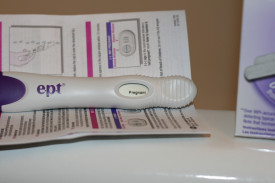
I want to be able to take matters into my own hands and make sure I cannot father a kid until I choose. –Brian, California
As a young sexually active male in a committed relationship, I would like to be able to choose, with certainty, whether or not I am fertile. —B. Cook, California
My fiancé wants to wait longer than I do to have kids. And he wants to be in control of that. If he is the one taking the contraceptive then he will feel like he has control over the timeline. –Sarah Danielson, Michigan
For a long time, outdated perceptions have contributed to the lack of investment in birth control for men. Since women traditionally have borne the primary burden of unwanted childbearing and parenting, decision makers have long assumed that men wouldn’t be interested in contraceptives—or would have a very low tolerance for cost, side effects, or hassle. Today, though, in the age of paternity tests and child support, with fathers and mothers sharing parenting responsibility—more and more men want to be in control of their own fertility.
In May 2013, when a Florida man found that his girlfriend was pregnant, he tricked her into taking an abortifacient—an act of physical assault. Ultimately, caught in a web of anti-abortion laws, he was charged not with assault but with fetal murder. Few people were sympathetic to his actions, but many were sympathetic to his plight. Men, like women, need effective tools for managing fertility if they are to have a hope of charting their own life course.
Interest in better male-controlled contraception varies widely depending on country and culture, but in a wide variety of countries more than half of men say they want better male birth control methods. After one study of male contraception sponsored by the World Health Organization, 85 percent of participants would have preferred to continue an experimental method rather than returning to whatever they used before—even though the experiment required a weekly injection.

A second longstanding misperception is that women can’t and won’t trust men for family planning. In truth, even with today’s limited options, meaning condoms and vasectomies, approximately one third of US couples rely on the man to provide contraception. A significant number of men who participate in clinical trials for male contraceptives say their wife or partner has had side effects from female methods or that they want to take the burden off of her for a while (Ringheim, 1995).
In general, people tend to overestimate the side effects of female birth control, falsely believing, for example, that contraceptives cause weight gain. But some female bodies respond poorly to even the micro-dose of copper or hormones present in top tier contraceptives, and for other women the cost of the most effective methods can be prohibitive. Barriers to access abound. Faced with the health risks of an unintended pregnancy a woman can feel caught between a rock and a hard place. Consequently, many women appreciate guys who step up to the plate. Of almost 2,000 women surveyed in Edinburgh, Shanghai, Hong Kong, and Cape Town, a vast majority said they thought a male pill was a good idea, and only two percent said they wouldn’t trust their partners to use it (Glasier, 2000).

To be frank, more men might do well to ask whether they should trust women to manage contraception. In the United States, with most contraception still in the hands of women, close to half of pregnancies are unintended, and the transition to thoughtful, intentional childbearing has been stalled for decades. Around a quarter of pregnancies occur in a month when a woman says she was contracepting. Like condoms, female barrier methods and even the Pill are quite subject to human error. In one study of 82 women, participants on average missed four or five pills per month, even when they were sent text-message reminders. It’s simply not reasonable to assume that ordinary human beings will do the same thing in the same way at the same time every day for forty years—or every time they have sex. While longer-acting “fit and forget” contraceptives like IUDs and implants appear to radically change the equation, so would an improved array of options for the male half of the human race.
On the surface, it may seem that scientific challenges are the primary barrier to excellent male birth control. A woman produces an egg only once each month, while men produce millions of sperm daily. Female fertility can be detected and timed. It starts later and ends sooner than male fertility. But those in the know say biology isn’t the problem. The question is one of politics and priorities. The National Institutes of Health summed up the problem in direct (if wonky) terms over a decade ago:
The lack of progress in developing affordable, safe, effective, and reversible male contraceptives is due not to the biological complexity involved in suppressing spermatogenesis [the production of sperm], but rather to social and economic/commercial constraints…
Today, research on male contraception is 50 years behind research on female contraception. The difference is as much as anything an artifact of history and tradition, which ripple into the present. Several years ago in a South African youth hostel, my daughters were horrified to encounter a young man who casually said that he wanted a dozen children. As they queried him, they got a glimpse into both his culture and our own—into all times and places where childcare has been primarily a female concern and males could count offspring like a banker counts dollars. But gender roles and parenting have evolved in the last 50 years, all in the direction of more equality, mutuality, and flexible division of labor between men and women. For many men, those changes include a desire to be deeply present in their children’s lives.
As men get more involved in late night diaper changes and storybook reading and getting kids off to school, their perspective on children looks more and more like that of women. They don’t want twelve kids. They want two or four or one, or sometimes, knowing their own limits, none at all. In other words, they want childbearing to be intentional, and they want to decide for themselves when the time is right. It’s time that they had the tools to do so.

Glasier, AF, R Anakwe, D Everington, CW Martin, Z van der Spuy, L Cheng, PC Ho, RA Anderson (2000) Would women trust their partners to use a male pill? Human Reproduction 15(3): 646–9.
Ringheim, K (1995) Evidence for the acceptability of an injectable hormonal method for men. Family Planning Perspectives 27(3): 123–8.
Thanks to S. Minden for her expert editing eye on this series.


Comments are closed.